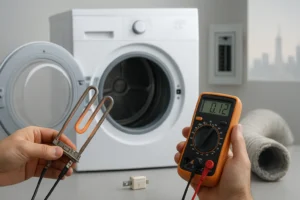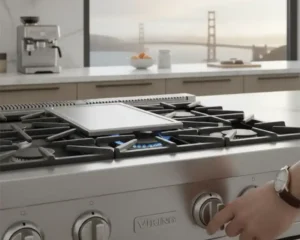Washing Machine Not Spinning? Here’s What You Need to Know
Is your washing machine not spinning and leaving you with soaking wet clothes? It is a common issue, but you can fix it with some troubleshooting. Whether it’s an imbalance, a clogged drain, or a mechanical fault, this guide will explain why a washing machine won’t spin and offer step-by-step solutions. If the goal is to avoid unnecessary costs and resolve the problem efficiently, continue reading to get things running smoothly again!
Common Causes of a Washing Machine Not Spinning
Lid Switch/Door Lock Malfunction: The washing machine is designed not to spin if the lid or door is open for safety reasons. A faulty lid switch (top-loading machines) or door lock (front-loading machines) can prevent the machine from spinning even if the lid/door is closed.
Faulty Motor Coupler (Direct Drive Washers): In direct drive washing machines (Where the motor directly connects to the transmission), a rubber or plastic coupler connects the motor to the transmission. This coupler can break or wear out, preventing the drum from spinning.
Worn Drive Belt (Belt-Driven Washers): A belt connects the motor to the drum in belt-driven washing machines. Over time, this belt can become worn, loose, or broken, causing the drum not to spin.
Problem with the Motor: The washing machine’s motor could be faulty, which is a more serious issue that usually requires professional repair or replacement.
Faulty Motor Control Board (or Electronic Control Board): The motor control board regulates power. If this board malfunctions, it can prevent the motor from spinning.
Faulty Timer or Control Knob: In older washing machines with mechanical timers or control knobs, a malfunction in these components can prevent the spin cycle from engaging.
Clogged Drain Hose or Pump: If the washing machine cannot drain the water properly, it will often not spin. A clogged drain hose or a faulty drain pump can prevent proper drainage.
Overloading the Washing Machine: Overloading the washing machine can strain the motor and other components, preventing the drum from spinning.
Problem with the Transmission: The transmission transfers power from the motor to the drum. A faulty transmission can prevent the spin cycle from working.
Loose Wiring or Connections: Loose wiring or corroded connections can interrupt the electrical signals needed for the spin cycle to function.
DIY Troubleshooting Steps for a Washer Not Spinning
- Check and Replace the Lid Switch/Door Lock
Instructions:
- Unplug the washing machine from the power source.
- For top-loading machines, use a multimeter to test the lid switch for continuity. If faulty, replace it.
- For front-loading machines, inspect the door lock assembly. Remove it carefully and check for any visible damage or wear. Replace if necessary.
Safety Precautions:
- Always disconnect the machine from power before accessing internal components.
- Wear insulated gloves when handling electrical components.
- Handle the door lock/lid switch assembly gently to avoid damaging nearby parts.
2. Inspect and Replace the Motor Coupler (Direct Drive Washers)
Instructions:
- Unplug the washer and remove the rear panel.
- Locate the motor coupler between the motor and transmission.
- Check for cracks or damage in the rubber or plastic coupler. Replace it if worn or broken.
- Reassemble the parts and test the washer.
Safety Precautions:
- Ensure the washer is unplugged to avoid electrical hazards.
- Use appropriate tools to prevent injury while removing or reassembling components.
3. Examine and Replace the Drive Belt (Belt-Driven Washers)
Instructions:
- Unplug the machine and remove the back panel.
- Locate the drive belt connecting the motor to the drum.
- Check for wear, looseness, or breakage. If the belt is damaged, remove it and install a new one.
- Ensure the new belt is properly aligned and tensioned.
Safety Precautions:
- Disconnect power before working on the machine.
- Be cautious of sharp edges on the back panel when removing it.
4. Test and Replace the Motor if Faulty
Instructions:
- Disconnect the washer from the power supply.
- Remove the back panel and disconnect the motor wires.
- Test the motor using a multimeter. If it shows no continuity or high resistance, replace it.
- Install the new motor and reconnect the wiring.
Safety Precautions:
- Avoid direct contact with motor terminals when testing.
- Handle the motor carefully—it may be heavy and have sharp edges.
5. Inspect the Motor Control Board and Replace if Malfunctioning
Instructions:
- Unplug the washing machine and remove the top or rear panel (depending on the model).
- Locate the motor control board and inspect for burn marks, blown capacitors, or other visible damage.
- Test the board with a multimeter. Replace it if it’s faulty.
- Reassemble and test the machine.
Safety Precautions:
- Always turn off and unplug the machine before opening it.
- Use proper tools and avoid touching other internal components.
6. Check and Replace the Faulty Timer or Control Knob
Instructions:
- Disconnect the washer from power.
- For mechanical timers, remove the control panel and inspect the timer or control knob.
- Test for continuity using a multimeter. Replace if faulty.
- For electronic control knobs, follow the manufacturer’s guidelines for replacement.
Safety Precautions:
- Disconnect the power before working on the control panel.
- Avoid applying excessive force when removing the control knob or timer.
7. Clean the Drain Hose and Check the Drain Pump for Blockages
Instructions:
- Turn off the power and water supply to the machine.
- Detach the drain hose and check for blockages. Clean thoroughly.
- Inspect the drain pump by removing the cover and checking for debris or damage.
- Reassemble and test for proper drainage.
Safety Precautions:
- Keep a towel or bucket nearby to catch any water left in the hose.
- Be careful when handling the drain pump, as it may have sharp edges.
8. Avoid Overloading the Washing Machine
Instructions:
- Distribute clothes evenly in the drum to prevent imbalance.
- Follow the manufacturer’s guidelines for the maximum load capacity.
- Run smaller loads if the machine frequently stops spinning.
Safety Precautions:
- Always stop the machine before adjusting the load.
- Avoid using force when opening or closing the lid/door.
9. Inspect and Replace a Faulty Transmission
Instructions:
- Disconnect the power and remove the back panel.
- Check the transmission for oil leaks or visible damage.
- If faulty, remove and replace it according to the washer’s manual.
- Reassemble all parts and test the washer.
Safety Precautions:
- Use gloves to avoid injury when handling heavy components.
- Secure all parts before turning the machine back on.
10 Check for Loose Wiring or Corroded Connections and Fix Them
Instructions:
- Unplug the machine and remove the back panel.
- Inspect all wiring connections, especially around the motor and control board.
- Tighten any loose connections and clean corroded terminals using a contact cleaner.
- Reassemble and test for proper functioning.
Safety Precautions:
- Ensure the power is off before touching any wiring.
- Use insulated tools to avoid electrical hazards.
When to Call a Professional for Washing Machine Repair
Although you can resolve many washing machine issues with DIY troubleshooting, certain situations require professional assistance. Complex problems such as a faulty motor, a broken transmission, or a malfunctioning motor control board often require specialized tools and expertise. Fixing these issues without proper knowledge can lead to further damage and costly repairs.
If you’ve tried the basic troubleshooting steps and your washing machine still won’t spin, it’s time to seek expert help. A professional technician can accurately diagnose and repair the problem, ensuring your appliance functions efficiently and safely. To get reliable and prompt service, check out our Washing Machine Repair page and schedule a repair today.
Preventive Maintenance Tips to Avoid Spinning Issues
Preventive care is key to keeping your washing machine running smoothly and avoiding frustrating issues like the drum not spinning. With regular maintenance, you can not only prevent common problems but also extend the lifespan of your appliance.
- Ensure Proper Load Balancing
Overloading or unevenly distributing clothes in the drum is a frequent cause of spinning issues. Always follow the manufacturer’s recommended load capacity and distribute clothes evenly during each cycle. This simple habit reduces the motor and suspension system strain, preventing unnecessary wear and tear.
2. Clean the Drain and Filter Regularly
A clogged drain hose or a dirty filter obstructs proper drainage, leading to spinning failures. Make it a routine to inspect and clean these parts every few months. Clear any debris or lint buildup from the filter and ensure the drain hose is free from blockages to keep your washer functioning efficiently.
3. Inspect and Maintain Essential Parts
Periodically check key components like the drive belt, motor, and lid switch for signs of wear or damage. Early detection of worn-out parts can prevent sudden breakdowns during a wash cycle. If you notice frayed belts or unusual noises, consider replacing the faulty parts to maintain optimal performance.
Final Thoughts
Dealing with a washing machine not spinning can be frustrating. Still, you can resolve most issues with the right approach through simple troubleshooting. This guide has covered the common causes and provided step-by-step DIY solutions to get your washer spinning again. Regular preventive maintenance, such as proper load balancing and periodic cleaning of the drain and filter, can help avoid these issues in the future and keep your appliance running smoothly.
If your washing machine still doesn’t spin after trying these solutions, it may be time to call a professional. For expert assistance and reliable repairs, visit our Washing Machine Repair service page and get the help you need to restore your washer’s performance.
Key Takeaways
- Common Causes of Spinning Issues : Problems like a faulty lid switch, worn drive belt, clogged drain hose, or motor issues can prevent a washing machine from spinning. Overloading and transmission faults are also frequent culprits.
- DIY Troubleshooting : Many spinning issues can be resolved at home by checking and replacing components such as the lid switch, drive belt, or motor coupler. Regular maintenance, like cleaning the drain hose and filter, is crucial.
- When to Call a Professional : Complex problems involving the motor, transmission, or control board often require professional repair. If DIY troubleshooting doesn’t work, seek expert assistance to avoid further damage.
- Preventive Maintenance : Proper load balancing, regular cleaning of drains and filters, and periodic inspection of key parts can prevent spinning issues and extend the appliance’s lifespan.
Most spinning problems can be fixed with simple troubleshooting. However, if issues persist after attempting repairs, it may be more economical to consult a professional or consider replacing the appliance.
Frequently Asked Questions (FAQs)
Q1: Why is my washing machine not spinning but still draining water?
Ans: This is a common issue that may occur due to a faulty lid switch, broken drive belt, or motor coupler failure.
Q2: How do I fix a washing machine that won’t spin on its own?
Ans: You can start by checking for imbalances, cleaning the drain hose, and inspecting essential parts like the lid switch or motor.
Q3: What causes a washing machine to stop spinning mid-cycle?
Ans: Mid-cycle spinning issues can be caused by overloading, a malfunctioning timer, or a problem with the motor control board.
Q4: How can I tell if my washing machine motor is bad?
Ans: If the washer won’t spin or makes unusual noises, test the motor using a multimeter for continuity or resistance.
Q5: Is it worth repairing a washing machine that won’t spin?
Ans: In many cases, DIY troubleshooting can resolve the issue. However, if the repair cost is too high, replacing the appliance might be more economical.
Q6: Can an overloaded washing machine stop spinning?
Ans: Yes, overloading can prevent the washer from spinning due to the excessive strain on the motor and suspension system.
Q7: Why won’t my front-load washing machine spin?
Ans: A front-load washer may not spin due to a faulty door lock, clogged drain pump, or worn-out drive belt.
Q8: What should I do if my washing machine doesn’t spin or agitate?
Ans: Inspect the drive belt, motor coupler, and transmission. Ensure there are no blockages in the drain system.
Q9: How often should I clean the drain filter to prevent spinning issues?
Ans: Cleaning the drain filter every three to six months helps maintain proper drainage and prevents spin cycle problems.
Q10: When should I call a professional for a washing machine that won’t spin?
Ans: If DIY troubleshooting doesn’t resolve the problem or if the motor, control board, or transmission is faulty, it’s best to seek professional help.






